A Novel Soluble Tin(IV) Porphyrin Modified Single-Walled Carbon Nanotube Nanohybrid With Light Harvesting Properties
Abstract
:1. Introduction
2. Results and Discussion
2.1. Characterization of the nanohybrid
2.2. Estimation of the solubility of the nanohybrid
2.3. NMR investigations
2.4. Absorption spectra investigations
2.5. Fluorescence and transient absorption spectra investigations
3. Experimental Section
3.1. Instruments and Measurements
3.2. Materials
3.3. Preparation of Tin porphyrin functionalized SWNTs nanohybrid (SWNT–SnDPP)
3.4. Determination of solubility
4. Conclusions
Acknowledgements
References
- Carbon Nanotubes: Synthesis, Structure, Properties and Applications; Dresselhaus, MS; Dresselhaus, G; Avouris, P (Eds.) Springer Verlag: Berlin, Germany, 2001.
- Rahman, GMA; Guldi, DM; Campideli, S; Prato, M. Electronically interacting single wall carbon nanotube–porphyrin nanohybrids. J Mater Chem 2006, 16, 62–65. [Google Scholar]
- Xu, H; Chen, H; Shi, M; Bai, R; Wang, M. A novel donor–acceptor heterojunction from singlewalled carbon nanotubes functionalized by erbium bisphthalocyanine. Mater Chem Phys 2005, 94, 342–346. [Google Scholar]
- Sun, YP; Fu, K; Lin, Y; Huang, W. Functionalized carbon nanotubes: properties and applications. Acc Chem Res 2002, 35, 1096–1104. [Google Scholar]
- Chen, J; Harmon, MA; Hu, H; Chen, Y; Rao, AM; Eklund, PC; Haddon, RC. Solution properties of single-walled carbon nanotubes. Science 1998, 282, 95–98. [Google Scholar]
- Sanders, JKM; Bampos, N; Clyde-Watson, Z; Darling, SL; Hawley, JC; Kim, HJ; Mak, CC; Webb, SJ. The Porphyrin Handbook; Kadish, KM, Smith, KM, Guilard, R, Eds.; Academic Press: London, 2000. [Google Scholar]
- Li, H; Martin, RB; Harruff, BA; Carino, RA; Allard, LF; Sun, YP. Single-walled carbon nanotubes tethered with porphyrins: synthesis and photophysical properties. Adv Mater 2004, 16, 896–900. [Google Scholar]
- Baskaran, D; Mays, JW; Zhang, XP; Bratcher, MS. Carbon nanotubes with covalently linked porphyrin antennae: photoinduced electron transfer. J Am Chem Soc 2005, 127, 6916–6917. [Google Scholar]
- Guldi, DM; Taieb, H; Rahman, GMA; Tagmatarchis, N; Prato, M. Novel photoactive singlewalled carbon nanotubeporphyrin polymer wraps: efficient and long-lived intracomlex charge separation. Adv Mater 2005, 17, 871–875. [Google Scholar]
- Murakami, H; Nomura, T; Nakashima, N. Noncovalent porphyrin-functionalized single-walled carbon nanotubes in solution and the formation of porphyrinnanotube nanocomposites. Chem Phys Lett 2003, 378, 481–485. [Google Scholar]
- Arnold, DP; Blok, J. The coordination chemistry of tin porphyrin complexes. Coor Chem Rev 2004, 248, 299–319. [Google Scholar] [Green Version]
- Hawley, JC; Bampos, N; Abraham, RJ; Sanders, JKM. Carboxylate and carboxylic acid recognition by tin(IV) porphyrins. Chem Commun 1998, 661–662. [Google Scholar]
- Sun, YP; Huang, W; Lin, Y; Fu, K; Kitaygorodskiy, A; Riddle, LA; Yu, YJ; Carroll, DL. Soluble dendron-functionalized carbon nanotubes: preparation, characterization, and properties. Chem Mater 2001, 13, 2864–2869. [Google Scholar]
- Liu, J; Rinzler, AG; Dai, H; Hafner, JH; Bradley, RK; Boul, PJ; Lu, A; Iverson, T; Shelimov, K; Huffman, CB; Rodriguez-Macias, F; Shon, Y; Lee, TR; Colbert, DT; Smalley, RE. Fullerene Pipes. Science 1998, 280, 1253–1256. [Google Scholar]
- Bahr, JL; Mickelson, ET; Bronikowski, MJ; Smalley, RE; Tour, JM. Dissolution of small diameter single-wall carbon nanotubes in organic solvents? Chem Commun 2001, 193–194. [Google Scholar]
- Haddon, RC. Magnetism of the carbon allotropes. Nature 1995, 378, 249–255. [Google Scholar]
- Ramirez, AP; Haddon, RC; Zhou, O; Fleming, RM; Zhang, J; McClure, SM; Smalley, RE. Magnetic susceptibility of molecular carbon: nanotubes and fullerite. Science 1994, 265, 84–86. [Google Scholar]
- Hemraj-Benny, T; Wong, SS. Silylation of single-walled carbon nanotubes. Chem Mater 2006, 18, 4827–4839. [Google Scholar]
- Crossley, MJ; Thordarson, P; Wu, RAS. Efficient formation of lipophilic dihydroxotin(IV) porphyrins and bisporphyrins. J Chem Soc Perkin Trans 1 2001, 2294–2302. [Google Scholar]
- Lv, X; Du, F; Ma, Y; Wu, Q; Chen, Y. Synthesis of high quality single-walled carbon nanotubes at large scale by electric arc using metal compounds. Carbon 2005, 43, 2020–2022. [Google Scholar]
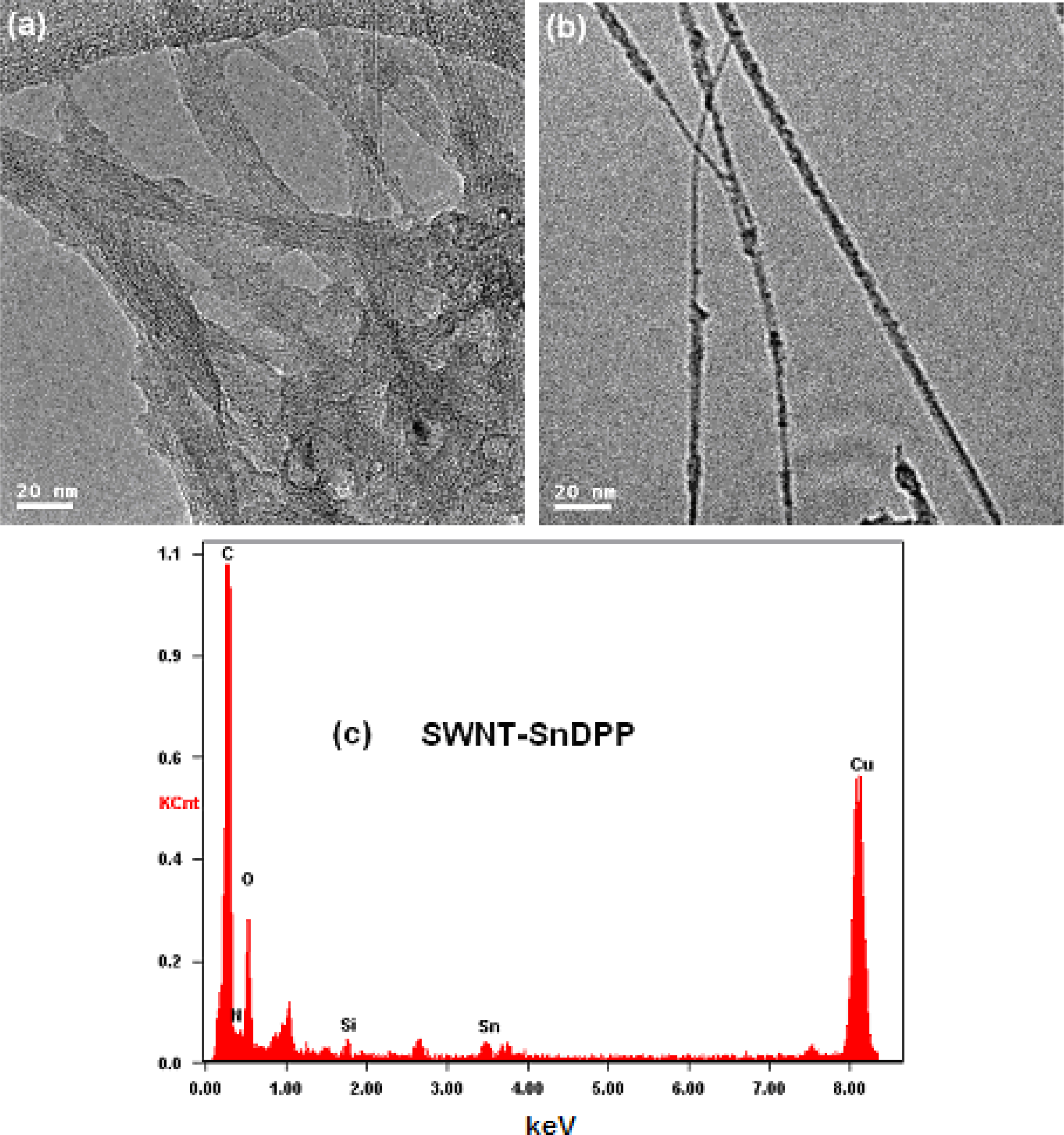
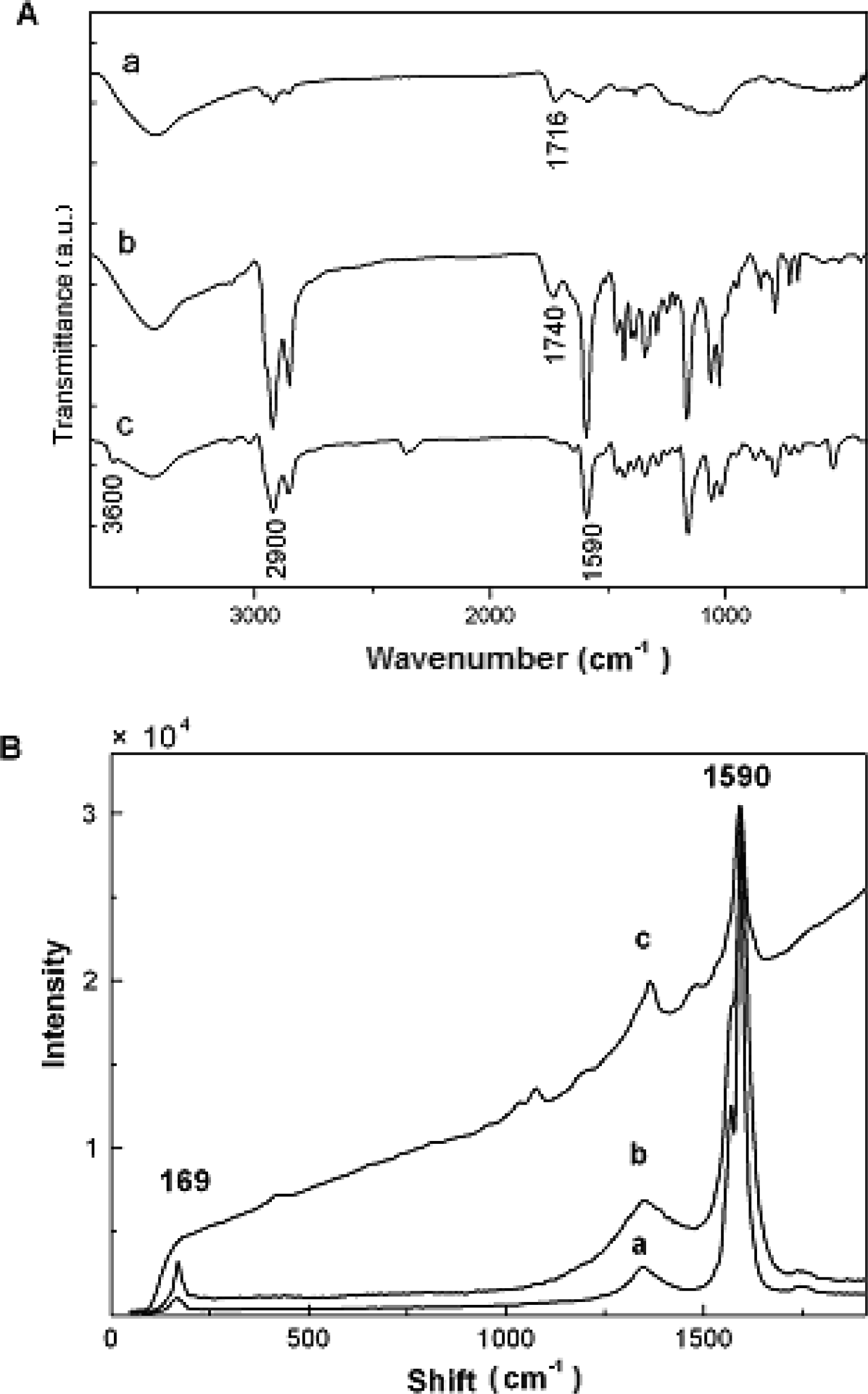
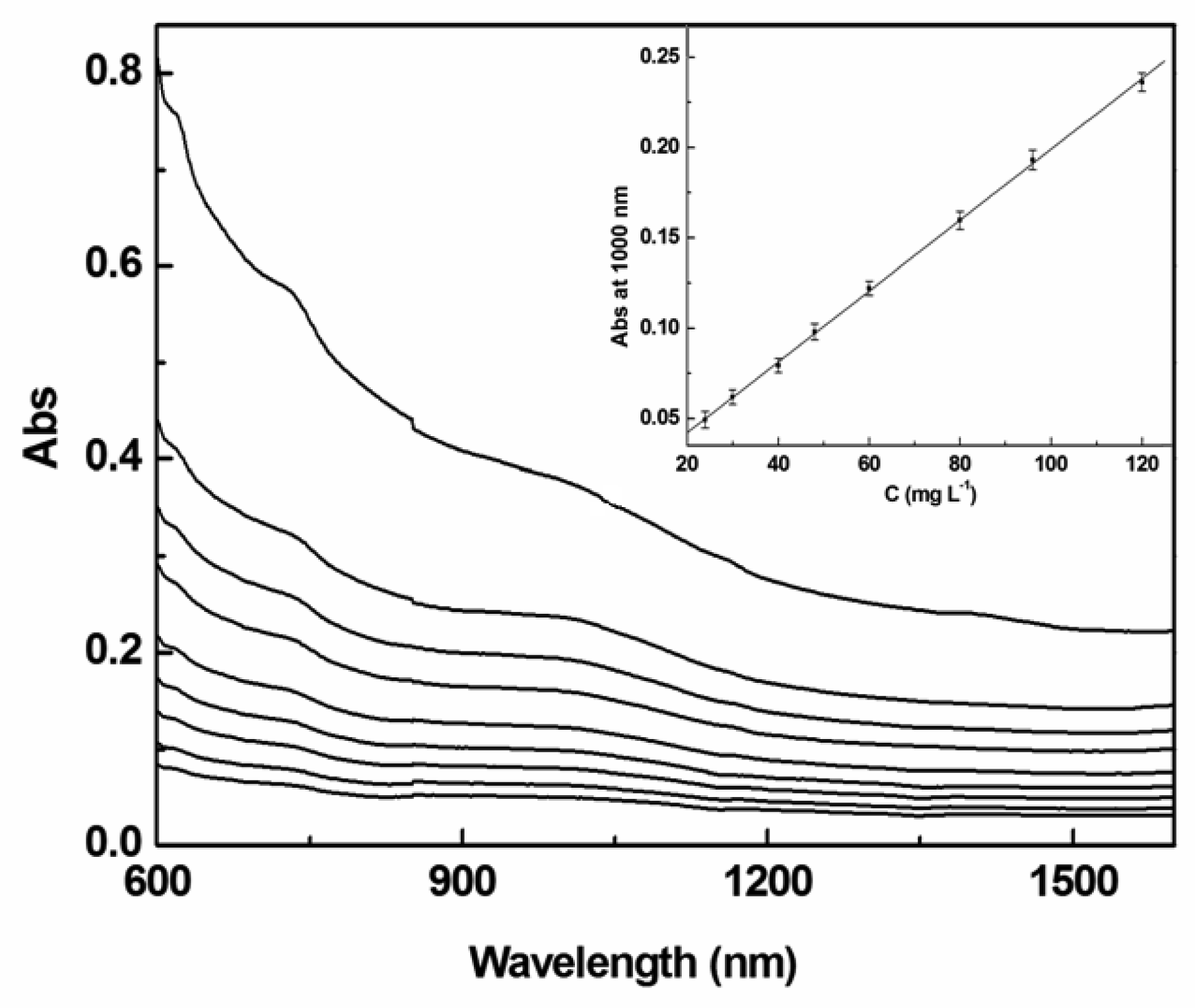

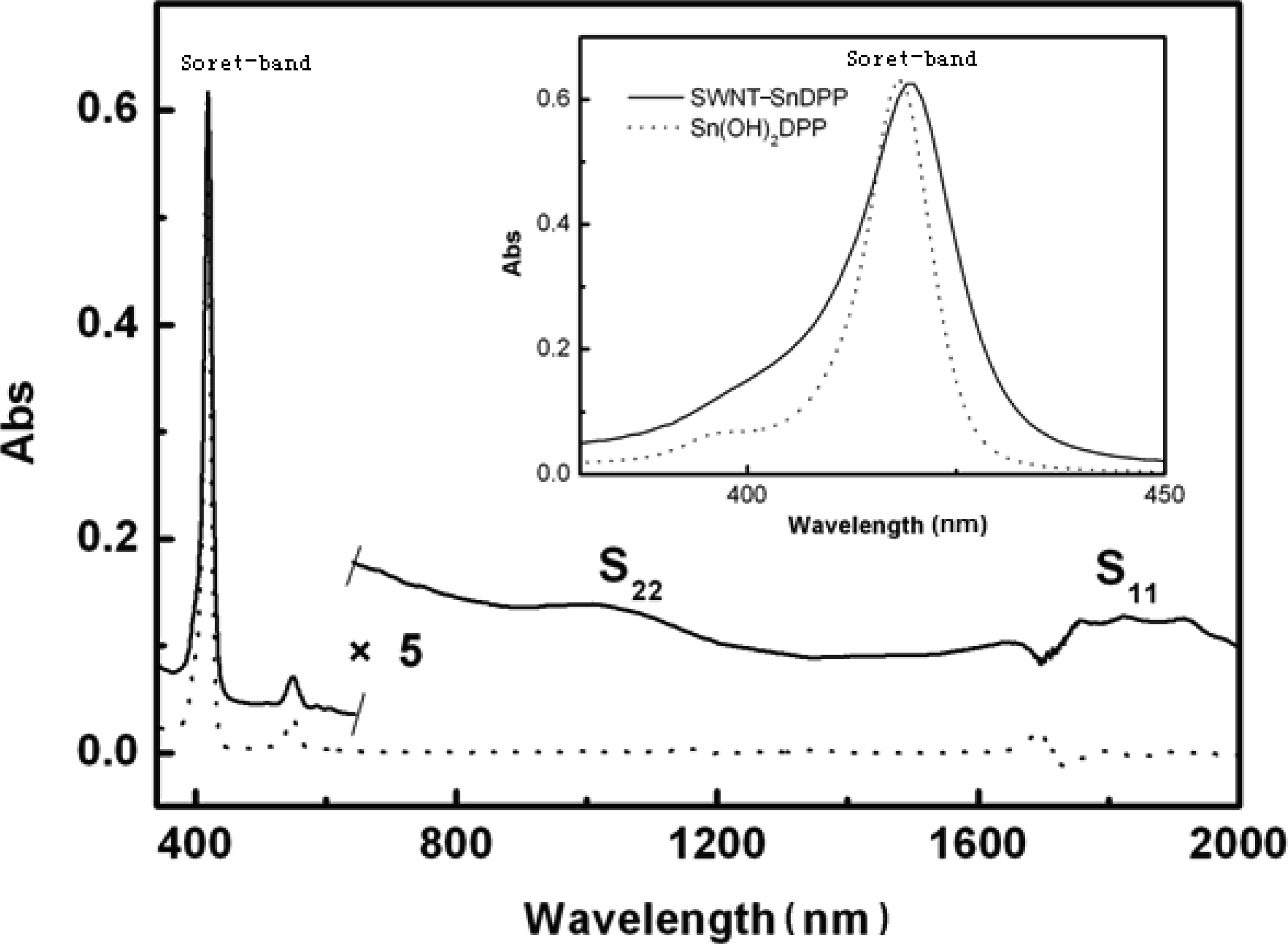
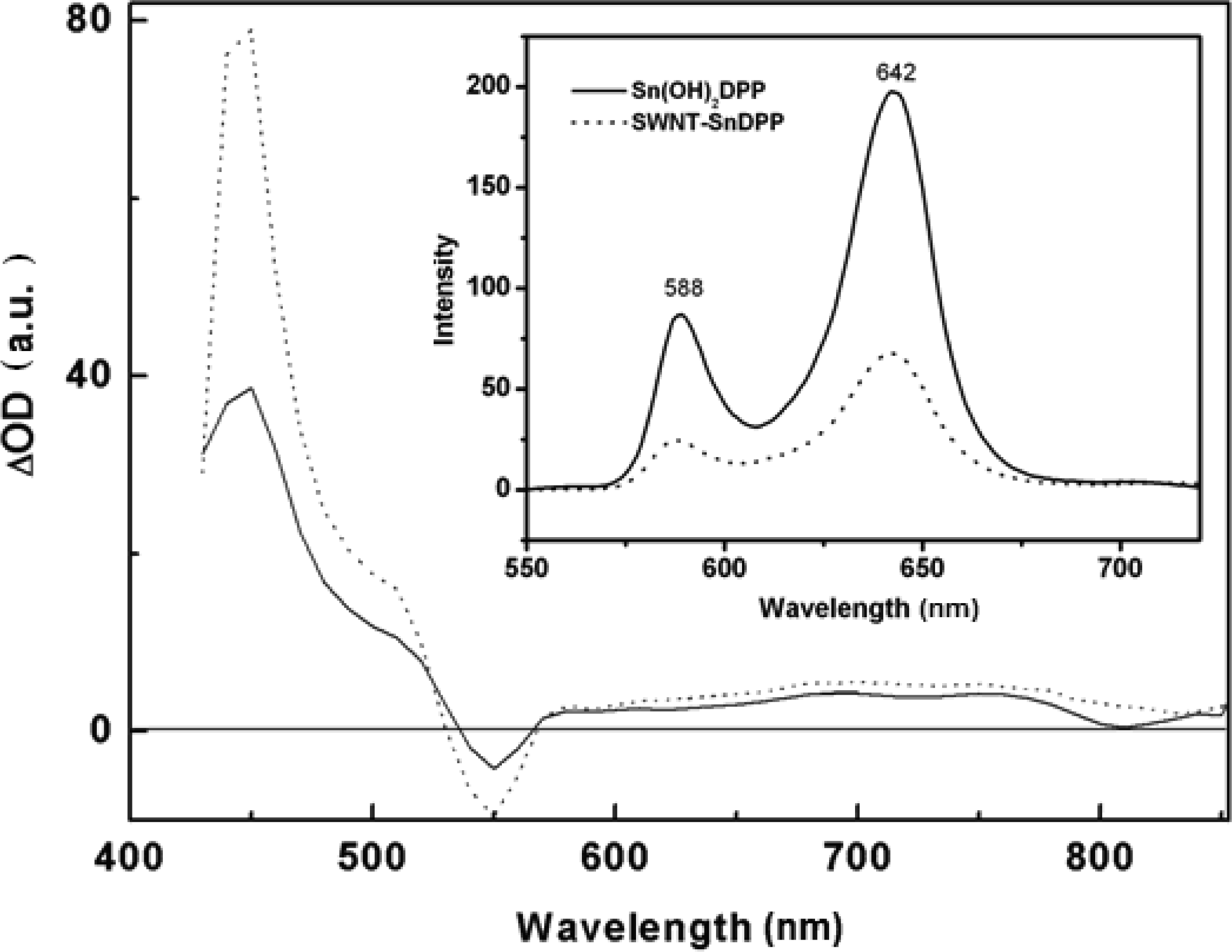

| Solvent | Solubility (mg/L) b |
|---|---|
| 1,2-Dichlorobenzene | 440 ± 4.6 |
| Chloroform | 358 ± 4.9 |
| Toluene | 237 ± 4.4 |
| Tetrahydrofuran | 209 ± 3.2 |
| Hexane | ——c |
| Ethanol | ——c |
| Methanol | ——c |
Share and Cite
Ren, D.-M.; Guo, Z.; Du, F.; Liu, Z.-F.; Zhou, Z.-C.; Shi, X.-Y.; Chen, Y.-S.; Zheng, J.-Y. A Novel Soluble Tin(IV) Porphyrin Modified Single-Walled Carbon Nanotube Nanohybrid With Light Harvesting Properties. Int. J. Mol. Sci. 2008, 9, 45-55. https://doi.org/10.3390/ijms9010045
Ren D-M, Guo Z, Du F, Liu Z-F, Zhou Z-C, Shi X-Y, Chen Y-S, Zheng J-Y. A Novel Soluble Tin(IV) Porphyrin Modified Single-Walled Carbon Nanotube Nanohybrid With Light Harvesting Properties. International Journal of Molecular Sciences. 2008; 9(1):45-55. https://doi.org/10.3390/ijms9010045
Chicago/Turabian StyleRen, Dong-Mei, Zheng Guo, Feng Du, Zun-Feng Liu, Zai-Chun Zhou, Xiu-Ying Shi, Yong-Sheng Chen, and Jian-Yu Zheng. 2008. "A Novel Soluble Tin(IV) Porphyrin Modified Single-Walled Carbon Nanotube Nanohybrid With Light Harvesting Properties" International Journal of Molecular Sciences 9, no. 1: 45-55. https://doi.org/10.3390/ijms9010045




